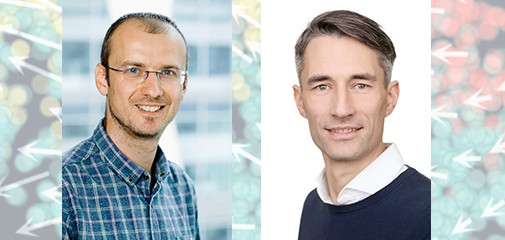Danish Single Cell Network launches new website to expand single cell technology in Denmark and beyond
The Danish Single-Cell Network was established in 2016 by the Khodosevich and Pers groups at the UCPH BRIC and Novo Nordisk Foundation Center for Basic Metabolic Research, respectively. The goal was to expand the knowledge and use of the new and promising single-cell sequencing technology. The network kicked off in January 2017 with a monthly seminar series consisting of progress reports, technology updates, keynote and industry speakers. Now, five years later, the Danish Single-Cell Network has more than 200 members, representing academic labs in all major Danish Universities (University of Copenhagen, Aarhus University, University of Southern Denmark, Danish Technical University, Aalborg University) and industrial partners. Today, the network launches a new website as part of their strategy to further expand the technology in Denmark and internationally. We asked the founders of the network group to answer a few questions about the network.

Why did you create the single cell network?
When we created the network back at 2016, the single-cell field was a promising (and very expensive) technology that could potentially become a powerful tool to study cellular composition of any tissue/organ and reveal a role for each cell type in disease conditions. However, at that time, the technology was available only in a small number of labs all over the world. Seeing the potential of the technology and having started to perform single cell experiments in our labs, we wanted to share the expertise with other labs and to consolidate efforts to expand single cell technology in Denmark. We planned to invite keynote experts, to enhance knowledge exchange and to facilitate collaborations within Denmark and internationally within the single-cell field. Nowadays, there are many labs in Denmark that perform top-quality research using single cell technology, a number of projects have been funded to study normal and diseased tissues by single cell methods, and Danish single cell community established a tradition of cooperation and mutual support. Thus, we believe that we reached our initial goals that we had back in 2016 and we move forward to further expand expertise in single cell research in Denmark and have international impact.
How do you believe that the new site singlecell.ku.dk will have an impact on researchers in DK and internationally?
Since the beginning, cooperation and knowledge exchange were the driving force in our network. We believe that the network helps to bring together groups with common interests and establish collaborations, both within Denmark and internationally with keynote experts that we invite to share their expertise. Knowledge exchange is a key factor and a number of labs started their projects using single cell technology after being exposed to single cell work in our network.
This week (week 15 Red) BRIC has celebrated the Brain Awareness week. The single-cell method is widely used in neuroscience – including your own research group, Konstantin Khodosevich, can you explain what the method means for neuroscience?
Cellular heterogeneity of the brain has been a major bottleneck in our understanding of brain function in heath and disease. To understand how the brain develops, we need to identify the initial stem cells, progenitors and how specific types of neurons and glia differentiate and mature. Similarly, to understand how the brain functions, we have to identify the cellular composition of the brain and how each distinct type of neurons and glia contributes to the concerted brain function. Finally, in order to treat brain disorders, we need to understand what kind of cells in the brain become unhealthy, those cells that trigger the disease and how each brain cell type contributes to disease etiology. Due to technology development, all of these questions can be addressed by single cell analyses, including single cell transcriptomics, epigenetics, proteomics and spatial omics methods.
Tune Pers, from your neuroendocrinology perspective, how do you think that single-cell sequencing will advance your field?
Currently there are few effective treatment options for obesity and also in diabetes care there is room for more effective ways to better control blood glucose. I think that we, in order to become better at treating and even preventing metabolic disease, need to deepen our understanding of how the brain regulates energy and glucose homeostasis. Especially single-cell epigenetics techniques will allow to connect regulatory genetic variants associated with obesity and type 2 diabetes to effector genes and cell types in the brain. These findings should help us to model how the brain can drive susceptibility to metabolic disease and thereby pave the way for new treatment options to combat metabolic disease.
Visit the new Danish Single Cell Network Website here
